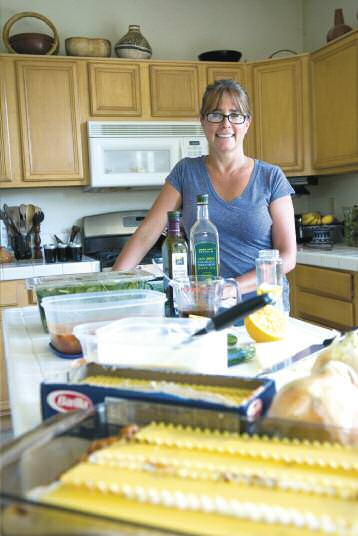cooks profile
CULINARY DIPLOMAT
Food connects Carina Black to the world.
WRITTEN BY JEANNE LAUF WALPOLE
PHOTO BY CANDICE NYANDO
As a child raised by Swiss parents in Argentina and Switzerland, Carina Black naturally developed a healthy appreciation for food starting at an early age.
“Most Swiss women spend their whole day preparing food for the family,” Black says. “The idea is to live off the land and to eat healthy.”
Embracing her Swiss heritage as an adult, Black frequently cooks at home for visitors from other cultures in her role as executive director of the Northern Nevada International Center in Reno.
“We call it food diplomacy. It’s a way to connect people who would not otherwise talk to each other. I have people in my house all the time,” she says.
Mixing Cultures
A typical evening at Black’s home might feature a group of Saudi men making coffee in the kitchen and a number of African women jumping on the trampoline in the backyard.
Although the intent is to showcase American food, Black plans her menus with sensitivity to a variety of food preferences. A typical buffet dinner for 30 guests could include lamb stew, salmon with rice, green salad, and couscous, for example.
Well-traveled and fluent in five languages, Black came to the United States when she was 18.
“I meant to stay for six months as an au pair, and then I met my husband at (University of Nevada, Reno),” she explains.
The six months extended into years, during which she earned an undergraduate degree in journalism and advanced degrees in political science.
Natural Foods
Black also imparts her devotion to natural foods to her husband, Greg, and their children, Nadeen, 21; Natasha, 18; Nia, 14; and Jordan, 11.
“Living healthy and not eating prepared food is important. Every night we sit down as a family and have dinner. That’s what my kids love,” she says.
An all-time family favorite is Black’s lasagna (recipe provided), as well as spaghetti, Indian dishes, and salads. The small family garden in the backyard often is a source of fresh ingredients for Black’s cuisine.
Following her lead, the family also is adventurous in their eating habits as Black explores eclectic cooking from around the world.
“My kids love to eat and will try anything,” she says.
In her periodic travels to the Middle East, Africa, and Central America for the NNIC, she especially looks forward to browsing the markets as a way to expand her knowledge about local foods.
Although she finds cooking to be an effective diplomatic tool, Black says it’s also great personal therapy for her.
“I use cooking as a way to separate from the crazy times that happen during the day,” she says. “Food is a huge part of our lives. It connects me to the world.”
Jeanne Lauf Walpole is a Reno-based freelance writer who has sampled everything from fertilized frog eggs to water buffalo jerky in her travels to other countries.
The Northern Nevada International Center seeks families or individuals interested in hosting dinner for groups of delegates through the U.S. Department of State’s International Visitor Leadership Program and other programs. For details about volunteer opportunities to host international visitors to the NNIC, contact Carina Black at Cblack@unr.edu.
Carina’s Lasagna
(Serves 5 to 6)
Bolognese Sauce
1 pound ground beef
1 large onion, chopped finely
½ garlic bulb (about 5 to 6 cloves)
4 to 5 large tomatoes, small dice
1 small can tomato paste
1 carrot, small dice
1 red or green bell pepper, preferably skinned, small dice
2 tablespoons Italian spices
½ cup red wine
Salt and pepper
1 bouillon cube
2 to 3 sprigs fresh basil
Béchamel Sauce
1 small white onion, chopped finely
2 tablespoons butter or olive oil
1 tablespoon flour
½ cup white wine
½ gallon milk
1½ cups shredded mozzarella (use high-quality cheese for better consistency in sauce)
½ tablespoon freshly ground nutmeg (if you have a nutmeg grinder — otherwise, it’s OK to use dried)
Salt and pepper to taste
Additional Ingredients
1 box lasagna noodles (“I use the small, flat ones,” Black says.)
To make the Bolognese sauce, sauté the garlic and onions in a large frying pan for about 5 to 10 minutes; then add meat and brown until done (about 10 minutes). Add carrot and bell pepper and continue to sauté. Add tomatoes, sauté another 10 minutes. Add red wine, sauté another 10 minutes. Add bouillon, Italian spices, and tomato paste. Once all ingredients are simmering nicely, turn down heat and cook for about 1 hour. If sauce gets too thick, add some water. Add fresh basil right before putting all ingredients into the dish.
For the béchamel sauce, sauté onions in butter or olive oil until golden brown. Add flour and stir for about 2 to 3 minutes. Add white wine and let thicken for a couple of minutes. Add milk, cheese, and all spices and cook for about 20 minutes, until cheese has melted into the milk. Make sure to stir consistently and don’t let it boil over (it makes a terrible mess on your stove).
In preparing the lasagna, ladle a small part of the béchamel sauce into the bottom of a 9-by-13-inch lasagna pan and the first layer of lasagna noodles (about four noodles). Add a layer of the Bolognese sauce, and then a thick layer of the béchamel sauce. Repeat two more times until all the Bolognese sauce has been used. Finish by pouring all the remaining béchamel sauce over the lasagna and bake for 50 to 60 minutes. Cook in 350 degree F oven.


